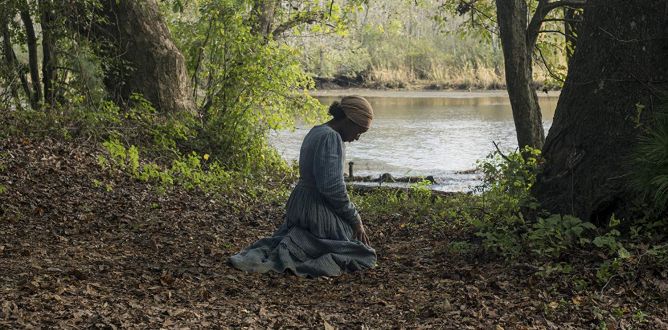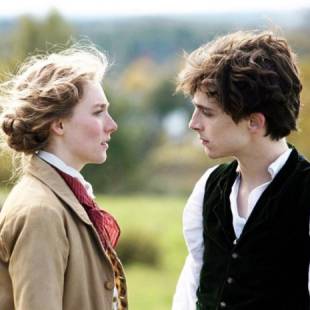Harriet Parent Guide
A gripping and inspiring glimpse into the life of a woman of unusual courage and power. Highly recommended for families with teenagers.
Parent Movie Review
There are a few people whose lives are so inspiring, whose courage is so remarkable, whose altruism is so extraordinary, that it is almost impossible to describe them. I am rarely at a loss for words but watching Harriet left me almost speechless, blinking back tears, and humbled by this glimpse into the life of a woman who is not only an inspiration to Americans, but to every person who believes in the inalienable human rights of liberty and dignity.
Harriet opens in 1849 in Maryland, with an enslaved 27 year old woman named Araminta “Minty” Ross (Cynthia Erivo) demanding her freedom. The will of her mother’s owner freed her and her children upon his death, but the current owner refuses to abide by it. Married to a free black man (Zackary Momoh), Minty cannot bear to bring children into a life of bondage. With her incensed owner (Joe Alwyn) threatening to sell her down the river, like her sisters before her, Minty decides to run for freedom. Her flight is all the more dangerous because she travels alone. Afraid her husband will be enslaved if he’s caught aiding her escape, Minty runs solo to Philadelphia, fleeing dogs, armed men, and fast-flowing rivers. Free in Pennsylvania, Minty chooses a new name: Harriet Tubman.
Harriet’s solo journey would have been a notable distinction for any woman. But it’s what she does next that makes her so unusual: she returns to lead her family, friends, and total strangers to freedom, over and over and over again. Named “Moses” by those who retell stories of her exploits, Harriet becomes a conductor on the Underground Railroad and then a spy for the Union Army in the Civil War.
Most of us watch people like Harriet Tubman with a sense of wonder, marveling at their selfless bravery. Why, we ask, do they do it? For Harriet, the answer is straightforward: love. Harriet loves her family and can’t enjoy her freedom in the shadow of their suffering. And she also loves God, who gives her visions and warnings, and in whom she has an unshakable faith.
With a main character who embodies love, selflessness, sacrifice, courage, faith, and unswerving duty, Harriet abounds with positive messages. Themes of racial equality and human dignity underpin the entire production. And while racism and slavery are emphatically condemned, Harriet acknowledges that good and evil aren’t the prerogative of any race: some white Americans work towards the abolition of slavery and two African Americans are shown helping slaveowners hunt down escaping men and women.
Slavery is a form of institutionalized violence, so it is not surprising that this film comes with some violent content, albeit highly sanitized. The most sickening episodes are referred to in conversation but there are numerous scenes of desperate souls being chased through the countryside by men with dogs and guns. There is also some bad language, principally multiple uses of a racial slur for African Americans, and a single use of the sexual expletive. These issues might trouble some viewers, but it would be impossible to make a historically accurate film about Harriet Tubman without violence, fear, and peril. That she not only survived, but endured with grace, dignity, and compassion, is a tribute to the highest qualities of the human spirit. And that’s something we all want our teenagers to see.
Directed by Kasi Lemmons. Starring Cynthia Erivo, Jennifer Nettles, and Janelle Monáe.. Running time: 125 minutes. Theatrical release November 1, 2019. Updated March 23, 2020Watch the trailer for Harriet
Harriet
Rating & Content Info
Why is Harriet rated PG-13? Harriet is rated PG-13 by the MPAA for thematic content throughout, violent material and language including racial epithets
Violence: There are numerous scenes of desperate people being chased through the woods by dogs and men with guns. A man hits another man with his gun. A woman watches her enslaved sisters being sold to another slaveholder. A man talks about a woman being burned alive and smelling like pork. A man rips up legal correspondence in front of the person it would help. A man hits a woman. A woman jumps off a bridge. A main character tells the story of having her skull cracked open by an overseer. A man repeatedly punches, kicks and stomps a woman; she dies. A man tries to choke a woman in front of her child. A woman tells about being branded with a hot iron; she shows her scars. Firearms are pointed and fired on several occasions. A main character ties up three people and then fires a warning shot between a man’s legs. A main character hijacks a wagon at gunpoint. A man shoots and kills another man for disobeying him. A woman shoots a man in the hand and then points the gun at his head.
Sexual Content: A husband and wife kiss. A woman’s dress is torn: her shoulder and upper chest are visible. A woman is seen removing her clothes to get into the bath: scars are seen on her back. A man changes his clothes, revealing scars on his back. There is mention of enslaved women being raped; no detail. There are two mentions of prostitutes; no detail..
Profanity: A man compares enslaved people to pet pigs. Racial slurs for African Americans are used frequently throughout the film. A crude term for women is also used on several occasions.
Alcohol / Drug Use: Men are seen drinking alcohol in the background. Men are seen drinking something unidentifiable, likely alcohol. A woman says she has given her baby laudanum (an opiate) to keep it quiet while they are on the run.
Page last updated March 23, 2020
Harriet Parents' Guide
Harriet took enormous risks to rescue her family and other enslaved persons when she could have enjoyed her personal safety and liberty in the North. Why do you think she was willing to do something so dangerous to help others? Are there any other people – either in your life or in history – whose courage and selflessness is inspiring to you? Are there any causes that you would be willing to take risks for?
In 2016, the Treasury Secretary announced that Harriet Tubman would replace Andrew Jackson on the front of the $20 bill. In 2019, the reworked $20 was paused, with no guarantees that Harriet Tubman would be on the bill. What do you think? Do you think she should be honored on the $20 bill?
Did you know that slavery and human trafficking still exist today? Learn more about freeing people from slavery through the National Underground Railroad Freedom Center.
Learn more about Harriet Tubman:
Harriet Tubman Historical Society
Smithsonianmag.com: The True Story Behind the Harriet Tubman Movie
Learn more about slavery in the United States.
New York Times Magazine: The 1619 Project
National Geographic: A History of Slavery in the United States
History.com: Slavery in America
Thirteen.org: Slavery and the Making of America
PBS.org: Conditions of antebellum slavery
Learn more about the Fugitive Slave Acts.
History.com: Fugitive Slave Acts
Time.com One of American History’s Worst Laws Was Passed 165 Years Ago
Learn more about the Underground Railroad.
History.com: Underground Railroad
The Atlantic: The Secret History of the Underground Railroad
National Park Service: What is the Underground Railroad?
Why do we use the term “enslaved person” instead of “slave”?
Chicago Tribune: Language matters: The shift from “slave” to “enslaved person” may be difficult, but it’s important.
Loved this movie? Try these books…
If you want to hear Harriet Tubman’s own words, read Harriet Tubman: The Moses of Her People, dictated by Harriet and edited by Sarah Bradford. Originally published in 1869, this biography was updated in 1886.
For readers seeking a solid historical biography that feels adventurous instead of academic, Catherine Clinton’s Harriet Tubman: The Road to Freedom is probably what you’re looking for.
Kate Clifford Larson’s Bound for the Promised Land: Harriet Tubman, Portrait of an American Hero also provides an in-depth, exhaustively researched look at this inspiring woman.
Harriet Tubman has also inspired novelists. In The Tubman Command: A Novel, Elizabeth Cobbs tells a tale of Harriet planning a plantation raid alongside a Union Army general.
If you want to give young readers an understanding of the horrors of slavery, find a copy of To Be a Slave. Written by Julius Lester, this book is a collection of first person accounts by African Americans who experienced enslavement in the United States. From abduction through to the Middle Passage across the Atlantic and on to life on plantations and attempts to escape, this is a powerful collection of tales of human courage and resilience in the face of atrocity.
Older readers with a similar interest should check out Frederick Douglass' Narrative of the Life of Frederick Douglass, an American Slave or Solomon Northup's 12 Years a Slave, both of which detail the brutalities of life in slavery, and the systems which propped up that institution.
Tween readers looking for information about Harriet Tubman can turn to Ann Petry’s biography, Harriet Tubman: Conductor on the Underground Railroad.
Home Video
The most recent home video release of Harriet movie is January 28, 2020. Here are some details…
Related home video titles:
For a searing depiction of slavery, older viewers can watch 12 Years a Slave. This moving film tells the true story of Solomon Northup, a free African American living in the North who was kidnapped and sold into slavery in the South.
Another story of escape on the Underground Railroad is told in Freedom. Action packed and full of stirring musical numbers, this film is sentimental but still suited for teens.
Ending slavery was a bloody episode in American history. Lincoln tells the story of Abraham Lincoln and his battles on the field and within the government to end human chattel slavery in the USA. And Gods and Generals follows the men on both sides who fought in the Civil War.
The US wasn’t the only country that struggled to end slavery, but Great Britain did it without bloodshed. Amazing Grace tells the true story of William Wilberforce and his decades long battle to pass abolition legislation through Parliament.


